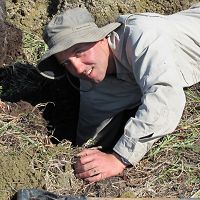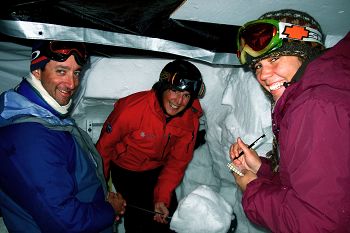Jepsen, et al., 2012
Interannual variability of snowmelt in the Sierra Nevada and Rocky Mountains, USA: Examples from two alpine watersheds.
Jepsen, S.M., N. P. Molotch, M.W. Williams, K.E. Rittger, J.O. Sickman (2012)
Water Resources Research 48 (2) Cross-CZO
-
Sierra, COLLABORATOR
-
Boulder, Sierra, INVESTIGATOR
-
Boulder, INVESTIGATOR
Abstract
Noah Molotch and grad students Ty Atkins and Danielle Perrot characterize snow properties inside a snowpit covered with tarps to prevent light contamination. Photo by Danielle Perrot.
The distribution of snow and the energy flux components of snowmelt are intrinsic characteristics of the alpine water cycle controlling the location of source waters and the effect of climate on streamflow. Interannual variability of these characteristics is relevant to the effect of climate change on alpine hydrology. Our objective is to characterize the interannual variability in the spatial distribution of snow and energy fluxes of snowmelt in watersheds of a maritime setting, Tokopah Basin (TOK) in California’s southern Sierra Nevada, and a continental setting, Green Lake 4 Valley (GLV4) in Colorado’s Front Range, using a 12 year database (1996–2007) of hydrometeorological observations and satellite-derived snow cover. Snowpacks observed in GLV4 exhibit substantially greater spatial variability than in TOK (0.75 versus 0.28 spatial coefficient of variation). In addition, modeling results indicate that the net turbulent energy flux contribution to snowmelt in GLV4 is, on average, 3 times greater in magnitude (mean 29% versus 10%) and interannual variability (standard deviation 17% versus 6%) than in TOK. These energy flux values exhibit strong seasonality, increasing as the melt season progresses to times later in the year (R2 1⁄4 0.54–0.77). This seasonality of energy flux appears to be associated with snowmelt rates that generally increase with onset date of melt (0.02 cm d−2). This seasonality in snowmelt rate, coupled to differences in hydrogeology, may account for the observed differences in correspondence between the timing of snowmelt and timing of streamflow in these watersheds.
Citation
Jepsen, S.M., N. P. Molotch, M.W. Williams, K.E. Rittger, J.O. Sickman (2012): Interannual variability of snowmelt in the Sierra Nevada and Rocky Mountains, USA: Examples from two alpine watersheds. Water Resources Research 48 (2). DOI: 10.1029/2011WR011006
Explore Further




